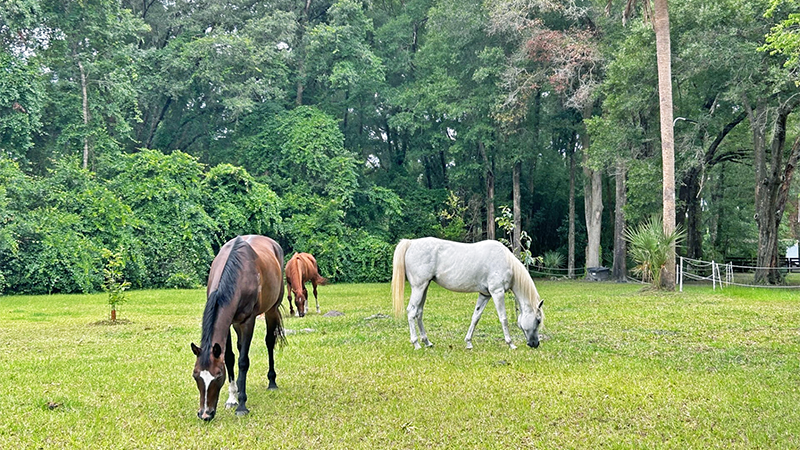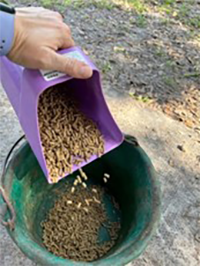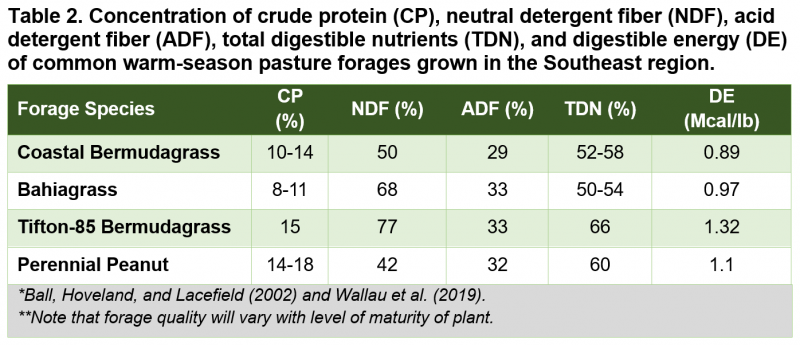
Many of Florida’s horses graze bahiagrass pasture with limited exercise. During the growing season when there is adequate forage for free choice grazing, a ration balancer feed may be all that is required to maintain body condition even for horses with a light exercise routine. Credit: Carissa Wickens, UF/IFAS
Carissa Wickens, UF/IFAS Extension Equine Specialist
Horses in Florida that live a predominantly sedentary lifestyle are categorized as horses at maintenance (i.e., the physiological state that involves maintaining daily bodily functions such as metabolism during rest, heart function, breathing, digestion, nervous tissue function; activity for maintenance, ie. walking to food/water, grazing; and temperature regulation). Many of the nearly 400,000 horses in Florida are primarily used for pleasure riding and recreational purposes and receive only intermittent work or structured exercise and are categorized as horses with light exercise. Examples of horses that fall into the maintenance and light exercise categories are horses that have been retired from competition, horses kept on farm to provide companionship for other horses, horses used for occasional trail riding or showing.
Horses require sufficient forage to obtain nutrients to maintain body condition and to ensure normal gastrointestinal function. A horse weighing 1,000 lbs. requires 15-25 lbs. of dry matter per day (1.5-2.5% of their body weight), which represents approximately 18-29 lbs. of hay or 50-100 lbs. of fresh forage, depending on the dry matter content of the forage. Horses at maintenance and those performing light exercise can meet most of their nutritional needs from pasture. However, horses grazing average or low-quality bahiagrass pasture may require protein and mineral supplementation. Another concern or challenge is when horses classified as easy keepers become overweight when managed on bahiagrass pasture. Table 1 shows the range of daily digestible energy and crude protein requirements for horses at maintenance and in light exercise (with a mature body weight of 880-1,100 lbs.). Table 2 shows a few of the nutrient concentrations of common warm-season pasture forages grown in Florida. This information is helpful for evaluating feeding programs for horses based on pasture productivity (pasture forage quantity and quality).

Figure 1. A ration balancer pellet is a nutrient dense feed offered in small amounts to provide protein, vitamins, and minerals needed to balance an all-forage diet of hay or pasture. Easy keepers and horses with metabolic conditions can also benefit from a ration balancer. Photo credit: Carissa Wickens, UF/IFAS.
Bahiagrass is the most cultivated summer perennial forage in Florida. Once established, bahiagrass has higher tolerance to heavy grazing compared to other commonly used pasture grasses and it generally requires less fertilization to maintain productivity. Peak production of bahiagrass is during the summer months, though some cultivars such as UF-Riata have earlier spring growth and continue to grow through the fall. Horses managed on bahiagrass pastures year-round will require supplemental forage (hay and/or alternative forage sources such as hay cubes) when the bahiagrass goes dormant in response to shorter day-length, lower temperatures, and/or lack of rainfall needed to support adequate forage growth. The nutritive value of bahiagrass is moderate (Table 2) but drops significantly with maturity. For more information on bahiagrass including recommendations for establishing and maintaining pastures refer to EDIS document AA216, Pasture and Forage Crops for Horses.
Monitoring the body condition score (BCS) of horses using the 1 to 9 Henneke BCS system (1 = Emaciated, 5 = Moderate/Ideal, 9 = Obese) will help determine whether the pasture is meeting their nutritional needs (the goal is to maintain horses in good condition at a BCS of 5-6). For horses at maintenance and in light work managed on bahiagrass pasture, a ration balancer pellet (Figure 1) can be fed to provide protein, vitamins, and minerals that are often lacking in a pasture only diet, without providing excess calories. A ration balancer is also a good option for horses with Cushing’s disease (pituitary pars intermedia dysfunction or PPID), laminitis, and hyperkalemic periodic paralysis (HYPP) as they contain lower concentrations of sugar and starch. The crude protein level in a ration balancer generally ranges from 28-32% and because these feed products contain concentrated levels of amino acids, vitamins, and minerals, they usually have lower feeding rates. For example, most mature horses only need to consume one to two pounds per day, thus incorporating a ration balancer into the horse’s feeding program may also help reduce feeding costs when combined with good pasture management practices. Most feed manufacturers offer a ration balancer in their product lines giving owners a good variety of choices (considering availability, price, the horse’s specific needs, and condition of the pasture).
–
References and Further Reading:
Pasture and Forage Crops for Horses
Body Condition Scoring of Horses
Ration Balancers: The story of how very little feed can go a long way
Concepts and Research-Based Guidelines for Forage-Livestock Systems in the Southeast Region
- Paying Attention to What Comes Out:Forage Transitions and Free Fecal Water Syndrome in Horses - August 2, 2024
- Feeding Horses Grazing Bahiagrass Pastures for Maintenance with Minimal or Light Exercise - August 25, 2023
- Corneal Ulcers in Horses: The Importance of Keeping an Eye on Your Horse’s Eyes - May 5, 2023


